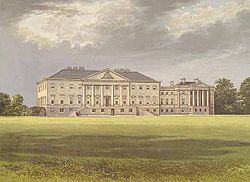- Nostell Priory
-
Nostell Priory is a Palladian house located in Nostell, near Crofton close to Wakefield, West Yorkshire, England, approached by the Doncaster road from Wakefield. Built on the site of a medieval priory for the Winn family from 1733 onwards, Nostell Priory is today a National Trust property.
Contents
History
The property was previously owned by the Gargrave family after being purchased in 1567 by Sir Thomas Gargrave, Speaker of the House of Commons from James Blunt, Lord Mountjoy, for £3,560.[1]
The estate was then purchased in 1654 by the London alderman Sir Rowland Winn after the previous owner was declared bankrupt in 1650. The building of the present house was started in 1733, and the furniture, furnishings and decorations made for the house remain in situ today. The family were textile merchants in London, George Wynne of Gwydir was appointed Draper to Elizabeth I, his grandson, Sir George Winn was created 1st Baronet of Nostell in 1660 and the family subsequently owed its wealth to the coal in the area, and later from leasing land in Lincolnshire for the mining of iron ore during the Industrial Revolution.
The house was built by James Paine for Sir Rowland Winn 4th Bart on the site of a 12th-century priory dedicated to Saint Oswald. Later, Robert Adam was commissioned to design additional wings, only one of which was to be completed, and complete the state rooms. Adam added a double staircase to the front of the house, and designed buildings on the estate, including the stable block.
Nostell Priory is home to a large and diverse collection of Chippendale furniture, all of which was made for the house. Thomas Chippendale was born in Otley in 1718 and had workshops in St Martins Lane, London. The Nostell Priory art collection includes The Procession to Calvary by Pieter Brueghel the Younger, William Hogarth's Scene from Shakespeare's The Tempest - the first depiction in a painting of any scene from Shakespeare's plays - and a self portrait by Angelica Kauffmann, as well as Rowland Lockey's copy of the painting by Hans Holbein (c1527 but now lost) of Sir Thomas More and his family; this copy was commissioned in 1592 by the More family and came to Nostell in the 18th century, and is said to be the most faithful to the destroyed original.
A longcase clock, with an almost completely wooden internal mechanism, made by John Harrison in 1717, is housed in the Billiard room. Harrison, whose father Henry is thought to have been an estate carpenter, was born within half a mile of the estate. He was referred to as John "Longitude" Harrison, after devoting his life to successfully solving the problem of finding longitude at sea by creating an accurate marine timekeeper. Known as H4, this chronometer can be seen at the Royal Observatory, Greenwich, London.
In May 2007, a set of Gillows furniture returned to the house after refurbishment. These pieces now furnish the Tapestry Room, as do a pair of large Venetian vases, made of wood inlaid with ivory and semi-precious stones.
The Adam stable block is currently undergoing major renovation and will reopen as an improved visitor centre with full access to facilities for visitors to both the park and the house.
In June 2009 a suite of bedrooms on the second floor of the house was formally handed to the National Trust. These guest bedrooms used by the Winn family, had never been on public view before. They contain their original contents, including a regency fourposter bed and suite of Victorian bedroom furniture. Another room for visitors to enjoy is the Butler's Pantry, with a display of Winn family silver, in the adjacent strongroom and the display cabinets.
Grounds
Nostell Priory occupies 121 hectares (300 acres) of parkland. Within the grounds and gardens of Nostell Priory are lakeside walks with a collection of rhododendrons and azaleas. The main frontage of the house is east facing towards a long grass vista. Leading down to the lake on the west side of the house is the West Lawn. The parkland includes lakeside and woodland walks, views of the Druid's bridge and walks to the restored Obelisk Lodge through wildflower meadows. The park was purchased from Lord St Oswald by the National Trust with funding from the Heritage Lottery fund. This grant also enabled the trust to acquire pictures, books, and furniture from the family.
Monastic history
The Priory was a twelfth-century Augustinian foundation, dedicated to St Oswald, supported initially by Robert de Lacy of Pontefract, and Thurstan of York.[2] By about 1114, Aldulf, confessor to Henry I of England, was prior of a group of regular canons at Nostell.[3] As part of the dissolution of the monasteries, the priory was shut down in 1540.[4] After the dissolution the lands of the priory came into the posession of Sir Thomas Gargrave, a High Sheriff of Yorkshire, Speaker of the House of Commons and president of the Council of the North.[5]
Notes
- ^ Bindoff, Stanley T. (1982). The House of Commons:1509-1558. London: Secker & Warburg. http://books.google.com/books?id=u_eIrJpc_T0C&pg=PA188&lpg=PA188&dq=elizabeth+levett+normanton&source=bl&ots=DoylcyHE03&sig=lwaA6At-caFW31vT17ThqsSBWaw&hl=en&ei=Cdm9Tce3GITGsAPEuMi_BQ&sa=X&oi=book_result&ct=result&resnum=1&ved=0CBUQ6AEwADgU#v=onepage&q=elizabeth%20levett%20normanton&f=false.
- ^ The Foundation of Nostell Priory, 1109-1153, (PDF)
- ^ David Knowles, The Monastic Order in England (second edition 1963), p. 229.
- ^ [1], with list of priors.
- ^ Biography of Thomas Gargrave, Chapters in the History of Yorkshire, James Joel Cartwright, 1872
External links
Categories:- Buildings and structures in Wakefield District
- Country houses in West Yorkshire
- National Trust properties in West Yorkshire
- Augustinian monasteries in England
- Gardens in West Yorkshire
- Historic house museums in West Yorkshire
Wikimedia Foundation. 2010.


